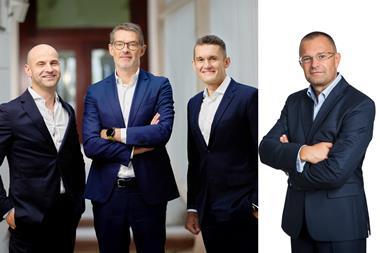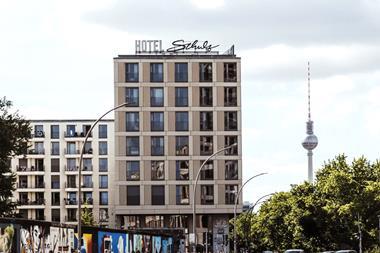In a downturn the secure income of healthcare makes it an attractive option for investors but beware political risk, as Christine Senior reports
Pension funds are mining previously untapped areas in the search for alternative assets for portfolio diversification and liability matching. Medical properties provide an alternative to commercial real estate, and the structure of the market offers diversification from mainstream property sectors.
Medical property is a fairly elastic term. Some fund managers include nursing homes and care homes for the elderly, others target doctors' surgeries, or either private or public hospitals, or clinics offering a number of medical services. And others lump medical property with other alternative assets in a diversified portfolio.
Some target o ne country, others a wider geographical spread. Medical property is also the focus of private equity and infrastructure investors.AXA REIM's Alternative Property Income Venture (APIV) invests in alternative real estate in leisure, residential and automotive, ranging from medical centres and nursing homes through to car parks and student accommodation.
Fund manager Ian Chappell estimates that, at the moment, around half of the fund's €500m is invested in medical healthcare property - nursing and care homes, clinics, rehabilitation clinics, private hospitals, doctors' surgeries - although the core area is care homes and rehabilitation clinics.
The geographical focus is mainly western Europe where there are established healthcare systems. Chappell says his fund has pension fund investors, mainly from France and Scandinavia, who like the security of healthcare assets: "The attraction for the pension fund is, although we are investing in healthcare, we are not investing in the operating business.
We are investing in leases, so there is quite a high level of security to the rent. And hopefully there is quite a high distribution return, which is what pension funds are keen to see." Long-term indexed income streams are the aspect of healthcare property that appeal to pension funds, according to Vicky Amlot, fund manager of Aviva Investors' Quercus Healthcare Fund.
"Traditionally there have been long leases with RPI uplift," she says. "The average lease on the Quercus portfolio is 30 years." The Quercus Healthcare Fund invests in UK healthcare properties - nursing homes for the elderly, and both specialist and independent hospitals.
Amlot says that just now these types of investments look good compared with the commercial property market: "In the current market other areas are seeing zero rental growth and not much prospect of rental growth over the next couple of years. We have an RPI link that is giving us 4-5% rental growth at the moment." Private health provision is not the only opportunity for investors to acquire a stake in healthcare property.
The provision of social infrastructure - schools, public sector hospitals, libraries, and so on - has also opened up to private investment with the private finance initiative and public private partnerships. Aviva's Lime Property Fund has invested in schools, libraries, and mental health hospitals. At the end of June, the fund's net asset value was £498m and healthcare properties made up a quarter of the portfolio by capital value.
Fund manager Joel Lindsey says the benefit for pension funds is the income received from distribution revenue, not rises in capital value. In the current climate, this type of property looks particularly attractive. "In a market like this," he says, " where commercial real estate is falling in value pretty quickly, it has less of an effect on the PFI sector.
There is fairly limited correlation in the performance of infrastructure and commercial real estate. The PFI is maintaining itself fairly well in terms of valuation." Lindsey says the fund fits into the alternative property category with an outperformance target of 150bps over gilts over the medium to long term. "It's almost a halfway mark between gilts and commercial real estate for pension schemes," he says.
The fund is not labelled an infrastructure fund, although it invests in social infrastructure, and differs from large infrastructure funds in that they can have a wide spread of investments from utilities to hospitals, and transactions tend to be much bigger, running into the billions of pounds, while the Lime Fund has an average investment of £30m (€38m)in one asset. As well as the benefit of long-term indexed income streams for pension fund investors, Lindsey also highlights the security of the counterparties, which are public sector.
The MedicX fund, a UK-based listed fund, specialises in investment in health centres - mostly new, purpose-built properties - where doctors' surgeries are often alongside other healthcare services such as pharmacies, dentists or physiotherapists' practices. Chairman of MedicX Keith Maddin believes that the future lies in these new purpose-built surgeries that, from an investment perspective, will have a long lifespan and provide a long-term steady income stream.
"The fund invests in property let for at least 20 years," he says. "We believe those buildings have much longer healthcare use, effectively giving long-term secure income flow based on providing core services to the community." The backing of the GP tenants by the National Health Service, and the fact that some buildings are leased to the NHS itself, are other factors that should give comfort to investors looking for secure income, says Maddin.
A regulated market and regular rent reviews are also plus points, which mean the sector has something in common with infrastructure investments. "Because the supply of new GP surgeries is controlled and nobody can develop a GP surgery without there being a practice, you don't have the void risk of other commercial property and you also don't have swings in rent reviews," he says. "You get steady, almost inflation-like, rental growth." The MedicX Fund, launched two years ago, has assets worth £160m, with around 45 properties, mostly in England and Wales.
The disadvantage, of course, for a pension fund of taking shares in a listed fund is the fact that the investment suffers the ups and downs of stock market investment, rather than being a pure play on the underlying assets. Although he accepts this is the case, Maddin counters that the MedicX fund has been less volatile than both real estate stocks generally and the FTSE.
In New Zealand, the ING Medical Properties Trust is proving attractive to local pension funds. The trust, worth NZ$300m (€136m), is invested in private hospitals, primary and community care centres (GP practices with other medical services such as radiology and pharmacy and physiotherapy) and other health-related property.
General manager David Carr cites the relative immunity of healthcare property to the ups and downs of the economic cycle as a major attraction for a pension fund investor. "They are investing in a property asset class, which is typically immune from economic and financial situations, as the underlying fundamental driver for the tenants and therefore income relates to the provision of healthcare.
While we may not participate in the significant upside in a bull market, when the downside comes along, we just keep the low-risk medium-return profile ticking along - around 80% of the trust rental income is increased annually by the consumer price index."
The New Zealand health service is relying more and more on private health service provision, so private hospitals are likely to benefit from rising demand. This is particularly important in the light of an ageing population, which should also increase business for private hospital care.
"Statistics show that the individual dollar spend per person over about the age of 60 essentially doubles," says Carr. "The public health system is also at capacity and waiting lists are typically excessive. Therefore, whether through medical insurance or by paying directly, individuals are now looking to the private sector for immediate surgery, rehabilitation and recovery."
Healthcare property is also a focus for private equity managers. In the UK, BUPA hospitals, for instance, have been bought out by private equity operator Cinven. Neil Gardiner, manager of the Quercus fund, emphasises the difference between the Quercus Fund and a private equity manager. "When we look at these investments we are taking a long-term view.
Our fund's life still has eight years left, whereas private equity look at these as shorter-term windows, taking positions using higher leveraging to enhance returns with a reasonably fast exit over typically three to five years. They make returns on valuation uplift and have much higher return targets as a result. We tend to look at things collectively both in terms of scale of our fund having diversification and looking at long-term income streams."
Within Europe there are significant differences between the way healthcare is structured. The risk profile of doctors' surgeries in the UK is different from that in Germany for instance. In the UK, rental income is relatively secure because it derives from funding from the local health authority. But the rent is only secure as long as the surgery retains the contract.
By contrast, in Germany, one building houses a number of different doctors each paying rent. "The risk there is more asset management risk," says Chappell. "You have to manage a multi-let building carefully. You could have areas vacant, you could have high non-recoverable costs such as service charges to pay because, in Germany, the lease structure is different, and the landlord has to pay for more."
Chappell highlights key risks for doctors' surgeries: the tenancy risk, of each individual doctor or practice; the risk from leases that are indexed; and location and building risk. "Most leases in this sector are indexed every year or couple of years, or every five years. Over time you need to be sure the business can grow at least at the same rate to keep profit margins the same for the operator and to make sure the rent can always be sustained.
Location and property quality are also important. If you have a new purpose-built facility, it's likely to become obsolete less quickly than an old building converted from a previous use, where rooms could be small and you may fall foul of health and safety legislation in the future, and it's impossible to upgrade."
With hospitals, Chappell says the risk is understanding where business is coming from, whether revenue is from government backing, from health insurance or from private payments in the various countries.
Swiss hospitals attract a lot of high-net-worth individuals, for example, while French hospitals are often public hospitals run by private operators, but subsidised by government to treat public patients. With any investment that is dependent on government backing, political risk is part of the equation. The government could change or have a change of policy.
This could have a rapid and radical effect on the attractiveness of the sector to investors. Amlot comments: "The private hospital market in the UK has benefited from effectively a privatisation of part of the NHS through outsourcing to private operators.
It's a matter of policy as to whether the government will continue. Private pay is increasing in this country, it has increased to 30 or 40%, but it is a sector that is impacted by government policy." And much discussion has centred on the notion that the market is becoming overheated. "Pricing is the biggest risk in an overheated market," says Lindsey. "It's a sector that has become very much in vogue for all the right reasons.
A huge amount of capital is chasing a limited pool of products. The risk is timing and entry into the infrastructure market. I think we will see that starting to change pretty quickly with the way capital markets are at the moment." Canadian pension fund Ontario Municipal Employees Retirement System, is one pension fund with investments in private healthcare provision.
Through its infrastructure arm Borealis, it has stakes in two public private partnership projects in Canada - the building and 25-year leasing of the William Osler Hospital in Brampton, Ontario, and in the Royal Ottawa, a 188-bed psychiatric hospital. It has also invested in LifeLabs, a laboratory testing service for doctors. But Dutch pension investor Mn Services has rejected the idea of investing in medical property in spite of its commitment to other forms of alternative real estate assets, such as hotels and student housing.
Herman Gelauff, research & strategy for international real estate at Mn Services, says: "We don't see the added value in term of risk/return of those properties compared with a portfolio without them." The fact that it is fairly regulated is one factor that makes it unattractive from Mn's perspective. "It limits what you can do with the building. Next to the risk return it's the main objection.
You don't have an exit alternative, so we concluded it wouldn't be of interest." Mn Services is seeking value-added type investments in its alternative real estate assets. "We are looking for more than inflation uplifts," says Gelauff. "If you look at it from the core perspective, it's completely secure, if you expect to rent it out for 10, 15 or 20 years to the same hospital, but that's not our play. We are normally looking for more opportunistic value added type of returns."












